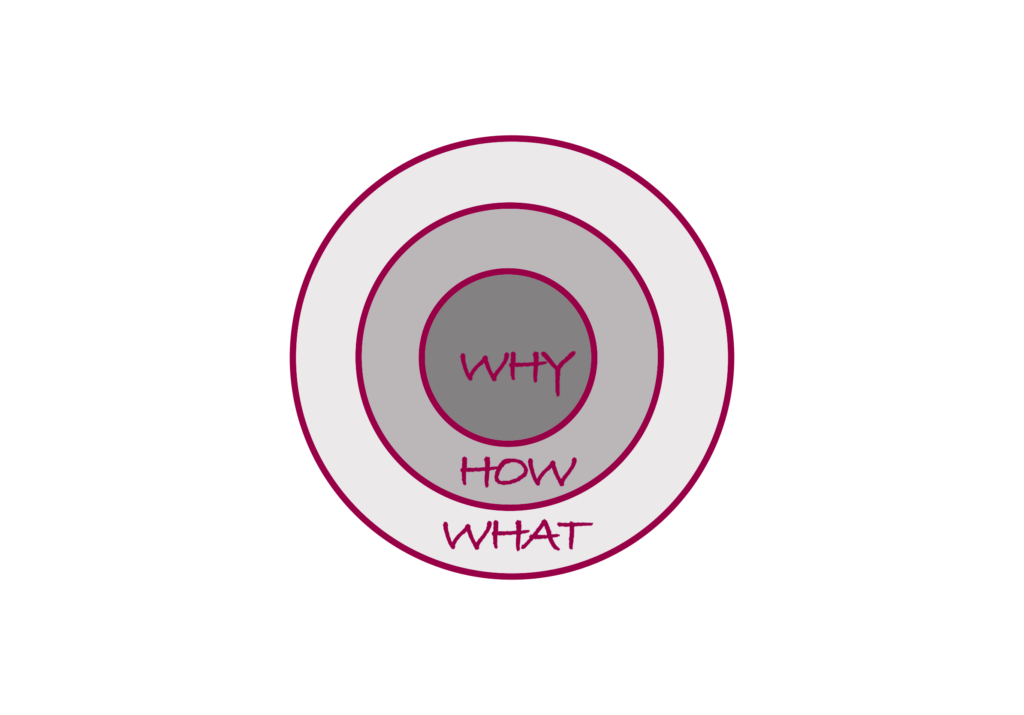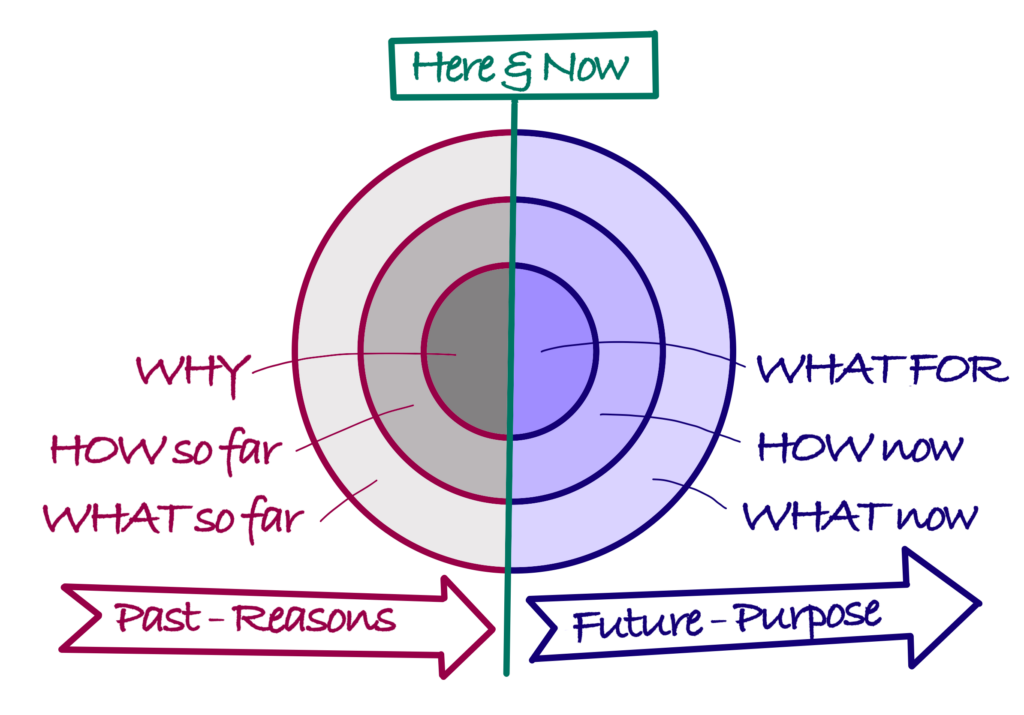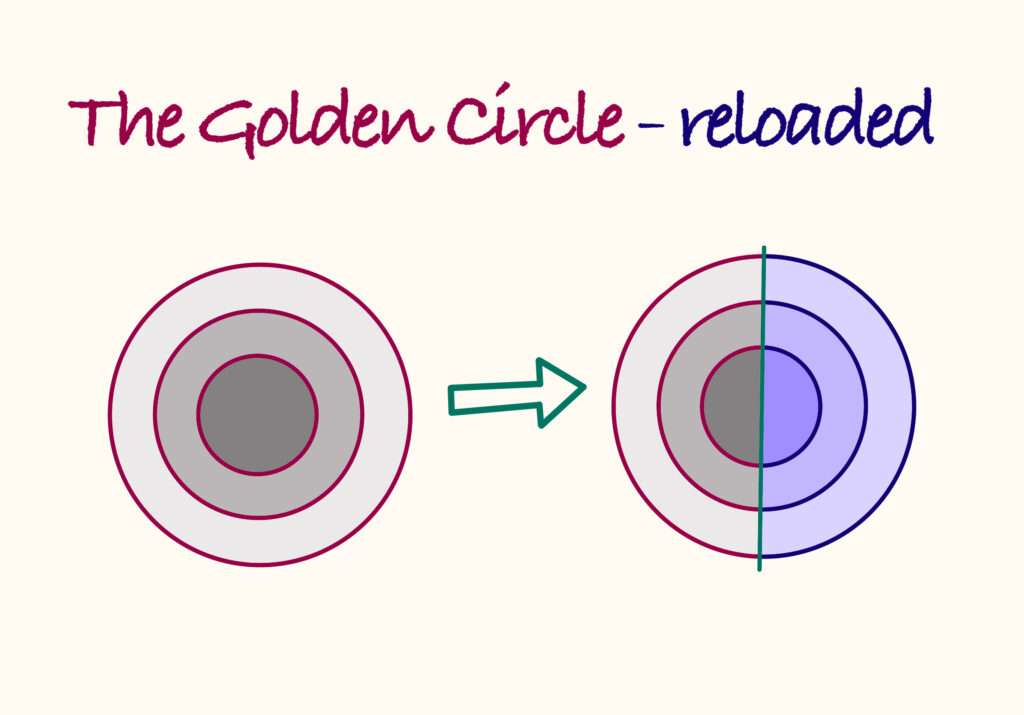The Golden Circle – reloaded
It was so nice to see him again. We hadn’t seen each other for such a long time, and finally we met again. There was so much to talk about, so many ideas to exchange. It was just so nice.
And then this…
The painful question
“But WHY do you want to write this book?”, my friend asked.
“I need to get all those ideas out of my head”, was my response.
His eyes widened, then a smile crept into the corners of his eyes. “So, there is limited space in your head, and you need to empty it?”
The question… hurt.
I was sitting on a bench with a friend, one afternoon in October in a nice park full of trees slowly giving in to autumn.
I had just unloaded a ton of entangled lines of thought and muddled ideas on him – ideas that had haunted me for years which I felt I needed to get out, out there, out of my head.
What I had wanted him to do is confirm that those ideas are brilliant, and that it would be worth sharing them.
But instead of this smooth confirmation, his helping hand in sorting through them and plainly figure out what should come first, he challenged me for my WHY.
Long after we parted, this question still lingered in my head. What was my WHY?
I piled up many reasons, analyzed and analyzed…. coming back to my initial feeling of “something needs to get out”. A classic case of analysis-paralysis.
So, why was I stuck on this simple question?
The Golden Circle
Knowing what I know, it should be… easy.
You may know the powerful work of Simon Sinek (https://simonsinek.com/golden-circle/), who touched millions of people with his TED talk and book “Start with Why”.
Quoting from the concept:
The Golden Circle is a seemingly simple yet hugely impactful notion. It helps to clarify, structure, communicate and implement a vision, be it at organizational or personal level. Simply summarized, the different rings are:
The WHY as your guide to prioritize and focus
The HOW translates into actionable steps to move forward
The WHAT is what you see as an output of activities
Simple, right?

What’s in the language?
I knew my WHY – at least so I thought.
Yet – why was it still so hard to get into action?
I realized, it’s a language thing.
WHY is a word loaded with multiple meanings.
It translates into multiple things in other languages.
In German: Warum – Wozu
In Spanish: Por qué – Para qué
In Russian: Почему – Зачем
In a simplified version, WHY is asking for the reason AND the purpose.
When I realized this first, it felt like splitting hair.
Language is a means to abstract thoughts and emotions, to simplify the richness of our sensory perceptions and filter mechanisms that help us to make sense of the world. Language is the medium to express what is going on in our minds.
While simplification is necessary and hugely helpful to communicate to others, there is a flip side to it.
Language also directs our thoughts and emotions if we are at the receiving end of it. What you hear or read unfolds into your own interpretations and sense-making, based on your experience and life story so far.
Spark and Flame
I realized I had understood the reason for my urge to write, but not yet the purpose.
I had discovered my WHY, but not yet my WHAT FOR.
I always had imagined the chain of events being like this:
Reason ==> action ==> impact
WHY ==> HOW & WHAT ==> impact
Easy, right?
But this might not be enough. Something is missing.
In my special case, this easy flow turned into this:
WHY ==> planning the WHAT & HOW
==> more planning ==> better planning
==> new planning ==> more detailed planning ==>
throwing it all away ==> starting something new.
Do you know this…? You do, don’t you?
Welcome to the world of large-scale procrastination.
A lot has been written about setting objectives and how to work on them.
We probably might have set a goal. A S.M.A.R.T. goal, I bet.
But often, taking action is still hard. It takes time and energy, there is a cost to achieving hard things. As compelling as it may sound, there is competition for our resources.
The formula to achieve a goal is this:
Gain from the goal > cost of making it happen ==> action
The gain from achieving the goal must be higher than the cost of making it happen to get us into action. The purpose must be larger than the effort to make it “worth it”.
Undoubtedly, the definition of “gain” and “cost” is highly individual. It is tightly interwoven with our values and beliefs, and the attempt to measuring it probably won’t be successful at the level of numbers and facts. But deep inside, you know what this means.
Language, deep dive
Let’s unpack this a little further.
Let’s explore the sisterhood of “why” and “what for”, and how both can help to enrich the coaching process, but also bring more depth into overall communication.
It would be easy to go into the etymology and linguistics of this topic, but this article focuses on its practical application in everyday communication.
Some thoughts and examples:
| WHY | <==> | WHAT FOR |
|---|---|---|
| Reason “Why do you study engineering?” “Because I am deeply interested in how things work.” | <==> | Purpose “What do you need the engineering degree for?” “It will open the doors to an impactful career.” |
| Cause Because something exists and causes my action | <==> | Effect Because something does not exist and needs my action to happen |
| Away-from “Why are you changing your job?” “It is too painful to work for this <insert insulting swearword to describe bad boss>.” | <==> | Towards “What are you changing your job for?” “I want more freedom of thought and time.” |
| Something in the past | <==> | Something in the future |
| Something safe we know Experience we gained | <==> | Something exciting we want Courage we are willing to invest |
| Our values and beliefs | <==> | Our aspirations and desires |
| Push | <==> | Pull |
| Pain | <==> | Gain |
Metaprograms
There are different ways people are wired. Motivation has different drivers for me than it has for you.
One way of looking at this might be through the lens of Metaprograms.
Metaprograms – a concept introduced in the 70s by Richard Bandler and John Grinder – describe the linguistic and cognitive patterns that influence a person’s perception, behavior and communication. In the broader sense, this includes how a person is motivated as one of the relevant dimensions of mindset.
The metaprogram that is at play in the context of this article – procrastinating the work on personal objectives – deals with the direction of our motivators. In a simplified notion, this can be either “away from” or “towards”. Probably there are as many shades in between those two extremes, but for the purpose of our reflection, let us leave it at that.
Being motivated by “away from” might show in a focus on the pain of a given or imagined situation. You want to get out of a job, away from a person, stop being overweight and breathless. Out of a discomfort, you want to stop what is happening now.
You might want to get those ideas out of your head, because they are haunting you.
Being motivated by “towards” might show in a focus on the gain of a given or imagined situation. You want to grow into a new role, create a loving relationship, get fit again. To get into a new comfort, you want to start what you want to happen next.
You might want to apply your ideas to achieve… what?
What seems to be a subtle linguistic difference turns out to be significant if you go deep into the reasons for procrastination.
Going back to the chain of events introduced earlier, we need to introduce an additional element. From
Reason ==> action ==> impact
WHY ==> HOW & WHAT ==> impact
We evolve to
Reason & purpose ==> action ==> impact
WHY & WHAT FOR ==> HOW & WHAT ==> impact
Knowing the reason is good, and for some people this might be sufficient to get into action.
But some feel the pain, understand the reason, and still procrastinate.
Those people need to do this one additional step – finding their purpose, and doing so in distinction from their reason. So that they are not only feeling the push away from what is painful, but also the pull towards what is desired instead.
In between lies the decision to act and set things in motion.
Away-from ==> decision to act ==> towards
How to put this into practice as a coach or self-coach
Two suggestions:
Deepen your conversations with additional nuance.
WHY and WHAT FOR are unequal sisters, yet sisters they are. Both questions are useful and will unveil different aspects of a situation or plan. When used in combination, there is deeper insight and understanding, touching different nuances of inner process and reasoning.
Insist on the stretch.
Extending the “5x why” approach, which goes deep into root cause analysis, we can apply the “5x what for” approach to go high on the hierarchy of motivators.
What for do you want to achieve your objective X?
What will be possible if this is done? Which doors will open? What for do you need those open doors? What will wait behind this door, once you stepped through?
A word of caution, though.
While you know quite well what you want to get “away from” – because you are experiencing it right now -, you might not know yet what the destination of your “towards” might look or feel like – because you have not yet been there.
So, let’s hope for very green grass at the other side.
The Golden Circle, extended version
Circling back to the Golden Circle (pun intended), here is a suggested extension to a split version for personal (self-) coaching:

| LEFT – the push | RIGHT – the pull |
|---|---|
| WHY: What is the reason that triggers me to set the objective? | WHAT FOR: What is the purpose I want to pursue by my objective? |
| HOW: How did I approach this in the past? How did I think about my objective? How did I behave to get where I am? | HOW: How will I need to change my approach in the future? How do I need to think to make it happen? |
| WHAT: What have I done until now that brought me where I am? What worked, what did not? What was useful, what was wasted? | WHAT: What will I do (differently) in the future? What actions will bring me closer to my objective? |
For a procrastinator, this reflection might look like this:
The push: I need to get those ideas out of my head. So far, I approached this with a rational mind – I set a S.M.A.R.T. goal and planned for execution. I approached it with a focus on daily habits and discipline.
The pull: I want to share my ideas so that they can grow and develop through the feedback I get from the community. I will approach this intuitively by selecting the topics I am currently most inspired by and where I think I can contribute to meaningful conversations. I will establish a dialogue between myself and an interested audience.
This blog is the beginning of something I don’t know yet, but feel very much pulled towards…
Get in Touch
What’s on your mind today? Share your thoughts and let’s connect.

